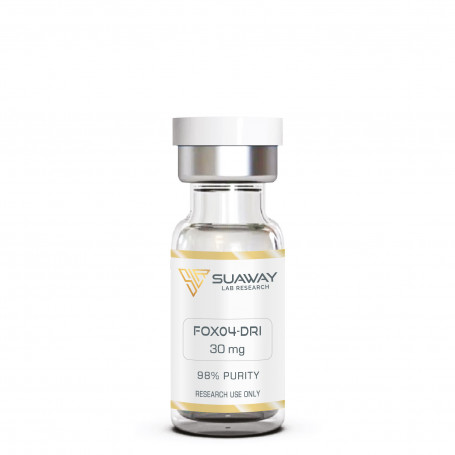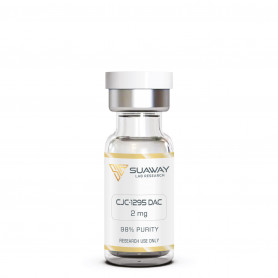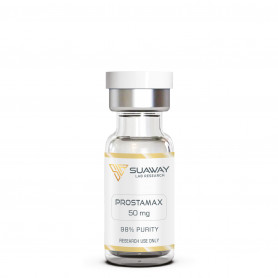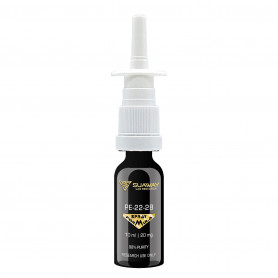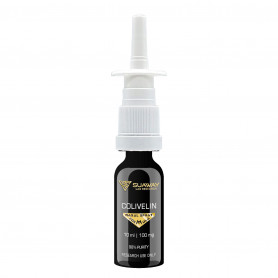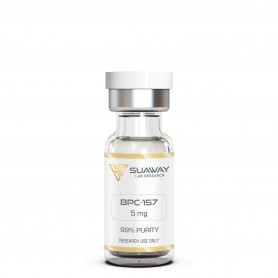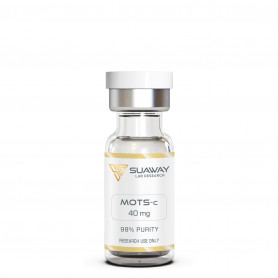FOX04 - DRI - 30 mg
FOXO4-DRI targets senescent cells for apoptosis, thereby reversing effects of aging. The result is an increase in overall fitness and improved function at the tissue and organ level. It has been shown that FOX04-DRI:
- Induces targeted apoptosis of senescent cells
- Restores fitness, hair density, and renal function
- Restores tissue homeostasis
Description
STRUCTURE
Sequence: H-D-Leu-D-Thr-D-Leu-D-Arg-D-Lys-D-Glu-D-Pro-D-Ala-D-Ser-D-Glu-D-Ile-D-Ala-D-Gln-D-Ser-D-Ile-D-Leu-D-Glu-D-Ala-D-Tyr-D-Ser-D-Gln-D-Asn-D-Gly-D-Trp-D-Ala-D-Asn-D-Arg-D-Arg-D-Ser-D-Gly-D-Gly-D-Lys-D-Arg-D-Pro-D-Pro-D-Pro-D-Arg-D-Arg-D-Arg-D-Gln-D-Arg-D-Arg-D-Lys-D-Lys-D-Arg-D-Gly-OH
Molecular Formula: C228H388N86O64
Molecular Weight: 5358.05
Peptide purity: greater than 98%
Other details: No TFA Salt, No Mannitol
Storage: Lyophilized peptide must be stored at -20°C and peptide solution at 4°C.
FOX04-DRI has low oral and excellent subcutaneous bioavailability.
DESCRITPION
After continuous exposure to intense stress or the effects of normal aging, a buildup of irreversible cellular damage shortens the health span.
It is believed that senescent cells affect the function of tissues and that clearing out their genetic material may postpone certain aspects of aging. Once it has been determined how senescent cells resist apoptosis, it will be possible to construct anti-aging medicines to determine whether or not homeostasis can also be restored. A FOXO4 peptide that interferes with the interaction between FOXO4 and p53 has been developed. This results in the selective exclusion of p53 from the nucleus and the induction of cell-intrinsic apoptosis in senescent cells.
In addition, it was able to restore fitness, fur density, and renal function in mice with naturally occurring aging as well as animals with accelerated aging caused by the XpdTTD/TTD mutation. Therefore, therapeutic targeting of senescent cells is achievable in circumstances in which damage has already been done to the body, and by doing so, tissue homeostasis may be efficiently restored.
DNA damage that is not repaired may cause dysfunction in cells, contribute to the development of diseases, and hasten the aging process.
Cells are equipped with a variety of DNA repair mechanisms to avoid such undesirable effects as a result of DNA damage. On the other hand, these methods are not without flaws. Even when tissue healing is insufficient, the integrity of the tissue may still be preserved, at least in the beginning, by independent stress-response mechanisms such as cellular senescence and apoptosis. Senescent cells are permanently removed from the cell cycle and, in most cases, establish a phenotype that is linked with persistent pro-inflammatory activity. This phenotype is known as the senescence-associated secretory phenotype.
On the other hand, in contrast to apoptotic cells, which are removed from the body for good, senescent cells may persist for extended periods and increase as a person becomes older. It is believed that persistent senescent cells speed up the aging process as well as the beginning of age-related illnesses. Senescence has been linked to a wide variety of diseases that are connected with aging, and genetic clearance of senescent cells has been shown to slow down certain aspects of the aging process. To a significant extent, it is still unknown how injured cells might resist apoptosis in favor of senescence over their lifespan.
FOXO4 is a gene that is a part of a larger collection of genes called transcription factor genes. These genes create transcription factor proteins, which play a crucial role in the processes of development and differentiation. Post-translational modifications are made to the FOXO4 protein throughout normal biological processes. These modifications change the DNA binding affinity of FOXO4, which enables it to regulate a wide variety of cellular pathways, including oxidative stress signaling, cellular senescence, apoptosis, insulin signaling, and the cell cycle itself. Other cellular processes that can be regulated include cellular senescence, apoptosis, and insulin signaling. It has been discovered that the placenta, ovaries, testes, adrenal glands, and fat cells all contain significant amounts of the FOXO4 protein.
The protein that is produced by the FOXO4 gene is similar to the FOXO4 D-Retro-Inverso variant, with the exception that the L amino acids that are normally present have been replaced with D amino acids. As a consequence of this, FOXO4-DRI is less susceptible to the physiological systems that are normally responsible for its clearance, and as a result, it stays in the body for longer periods. However, despite its modifications, the protein is still capable of affecting cellular pathways and transcription. In a broad sense, the FOXO4-DRI protein disrupts the typical operation of the FOXO4 gene.
The potential of FOXO4-DRI to interfere with normal FOXO4 signaling in the cell cycle by blocking the binding of FOXO4 to p53 is of particular importance in terms of aging and senescence. This is achieved by preventing the binding of FOXO4 to p53. The p53 protein is an essential regulator that plays a role in both the normal course of the cell cycle and the execution of programmed cell death (apoptosis). When FOXO4-DRI connects to p53, it stops FOXO4 from attaching, which in turn makes it possible for p53 to bind to DNA. In turn, this makes it possible for the cell to continue the process of apoptosis and ultimately die. It is interesting to note that FOXO4-DRI only seems to have this impact on senescent cells, which are cells that have lost their ability to function or have become dysfunctional as a result of aging. FOXO4-DRI helps clear tissue of cells that are just dead weight by focusing on defective cells, which it does so by targeting them. This, in turn, enables the tissue to function more effectively and helps to encourage the creation and differentiation of younger, more robust cells. Better biological function and, hence, a lower "biological age" are the results of this process.
It is thought that with the assistance of FOXO4-DRI peptide, it will accelerate the natural process of the body and destroy all of the defective cells, which may help prevent age-related cardiac illnesses from occurring.
FOXO proteins have been demonstrated to modulate the insulin signaling pathway, where they control the inhibitory activities of the insulin that are most engaged in cell metabolism, cell cycle, oxidative stress, senescence, and aging, according to research that was published in 2017. How the FOXO4-DRI peptide operates may increase the downstream effects of insulin, which will ultimately result in a reduction in levels of blood sugar that are excessive. Because of this, further issues resulting from changed FOXO levels and insulin pathways may be avoided.
It is common knowledge that as one gets older, their cognitive abilities begin to deteriorate. It is assumed that variations in the activity of the proteasome enzyme with increasing age are what causes cognitive impairment; nevertheless, the pathophysiology of some neurological illnesses, such as Alzheimer's, is still not fully understood.
Studies have shown that conditions such as Parkinson's disease, Alzheimer's disease, and Prion disease are associated with a reduction in the activity of the proteasome. It is unknown whether or not the downregulation in question is the fundamental cause of these disorders; nonetheless, there is little doubt that it is a factor contributing to their development.
Research that is still ongoing has demonstrated that people who suffer from neurodegenerative illnesses (NDDs) have abnormally low amounts of FOXO proteins in their central nervous systems. This has led to the assumption that exogenous FOXO protein, such as FOXO4-DRI peptide, may aid in controlling appropriate levels of FOXO proteins and may thus prevent or ease the development of any NDDs related to this mechanism.
Late-onset hypogonadism (also known as LOH) is a condition that affects many men as they age and is characterized by low levels of blood testosterone, a lack of sexual drive, erectile dysfunction, as well as obesity, and depression. This condition is related to aging. The primary reason for this is that the Leydig cells, which are cells that are located near the tubules in the testicles, begin to age and lose their ability to function normally.
Research to establish the utility of FOXO4-DRI peptide in the treatment of age-related male LOH was carried out. We employed an in vitro model that was made out of Leydig cells that had reached their end of life. These Leydig cells had previously been taken from male mice and subjected to chemical treatment with hydrogen peroxide, which resulted in the senescence of the cells.
After investigating these damaged cells, the researchers found that when isolated senescence cells were treated with FOXO4-DRI peptide, it inhibited the activity of FOXO4 protein and made it possible for p53 to bind with DNA. This action ultimately resulted in the senescent Leydig cells undergoing apoptosis.
In yet another research, naturally, aged mice were given FOXO4-DRI peptide, which was shown to enhance the health and functioning of Leydig cells. This, in turn, leads to better testicular functioning and higher testosterone release.
These findings suggest that the peptide may potentially be effective in the therapeutic setting for treating male patients with late-onset hypogonadism.
REFERENCES
G. Murtaza et al., "FOXO Transcriptional Factors and Long-Term Living" [PubMed]
M.P. Baar et al., "Targeted Apoptosis of Senescent Cells Restores Tissue Homeostasis in Response to Chemotoxicity and Aging" [Cell]
C. Zhang et al., "FOXO4-DRI alleviates age-related testosterone secretion insufficiency by targeting senescent Leydig cells in aged mice" [PubMed]
C. Zhang et al., "FOXO4-DRI alleviates age-related testosterone secretion insufficiency by targeting senescent Leydig cells in aged mice" [PubMed]
S. Lee et al., "FoxO integration of insulin signaling with glucose and lipid metabolism" [PubMed]
W. Hu et al., "Roles of forkhead box O (FoxO) transcription factors in neurodegenerative diseases: A panoramic view" [Progress in Neurobiology]
Y. Huang et al., "Senolytic Peptide FOXO4-DRI Selectively Removes Senescent Cells From in vitro Expanded Human Chondrocytes" [PubMed]
A.L. Bulteau et al., "Age-Dependent Declines in Proteasome Activity in the Heart" [Archives of Biochemistry and Biophysics]
A. Ciechanover et al., "The ubiquitin proteasome system in neurodegenerative diseases: sometimes the chicken, sometimes the egg" [PubMed]
Y. Sun et al., "FOXO4 Inhibits the Migration and Metastasis of Colorectal Cancer by Regulating the APC2/β-Catenin Axis" [PubMed]
P. Krimpenfort et al., "Rejuvenation by Therapeutic Elimination of Senescent Cells" [PubMed]
DISCLAIMER
This product is intendend for lab research and development use only. These studies are performed outside of the body. This product is not medicines or drugs and has not been approved by the FDA or EMA to prevent, treat or cure any medical condition, ailment or disease. Bodily introduction of any kind into humans or animals is strictly forbidden by law. This product should only be handled by licensed, qualified professionals.
All product information provided on this website is for informational and educational purposes only.

